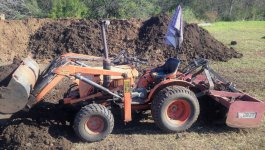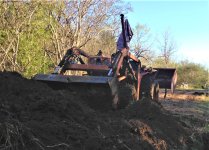So as one of the (as far as i know)
extremely few people to have any sort of electrically-powered top link (although not tilt), i'm still basically on the side of hydraulics.
The thing about hydraulic cylinders is that when the control valve for said circuit is closed (to the cylinder), the cylinder itself is essentially a solid object, and if you did push/pull on it extremely hard it is likely that a hose or fitting between the cylinder and valve will the failure point due to a pressure spike in the fluid. The hose and fitting are replaceable and relatively cheap. Hydraulic cylinders and circuits are essentially even stronger when sitting still than they are when moving and the forces move through the fluid.
On an electric linear actuator, there is a relatively small/weak electric motor hooked through a gear reduction 'transmission' to a threaded shaft. You can make an electric actuator as strong as a hydraulic cylinder, but even if you do, any impacts to the cylinder are NOT borne by fluid. Those forces go across machine threads and gear teeth in the very compact transmission. Electric actuators are just fine at moving 'dead' loads that don't really put any dynamic forces back into the actuator, but any time a 3pt implement bumps or snags over something or even just moves the 3pt up due to the contour of the terrain and then is allowed to fall back down to the previous height, you have a bunch of dynamic 'hits/judders/etc' going through whatever parts happen to be touching at the moment in the 'drivetrain' (these few threads, these few teeth etc) and the long term durability of it is suspect unless you upsize it well beyond the equivalent hydraulic setup in both physical size and cost. If you do manage to damage the drivetrain, it will be basically unrepairable, whereas the hydraulic system repair is usually just hoses, sometimes o-rings and lip seals inside the cylinder, or the rare worst case scenario of severely bending the cylinder rod which may still be individually replaceable without the cylinder being a 'total loss'.
My electric top link is actually just a hydraulic cylinder with an on-board self-contained pump/valve unit, called an electro-hydraulic actuator (EHA). The 'plumbing' has all the ease of an electric linear actuator because all you do is flip the polarity of two wires to make it extend and retract, but the 'impact/vibration resistance' is more in line with a regular old hydraulic cylinder.
Im not saying don't try it, im just saying pushing and pulling isn't the ENTIRETY of the job of your typical hydraulic cylinder, and resisting 'external' forces turns out to be something they're exceedingly good at. Linear actuators can do the pushing and pulling, but what you gain in ease of installation you
might be trading away in long-term durability.
Here's a pic where you can see the electrohydraulic top link in profile at max extension, and another picture showing the same box blade tilted all the way forward (cylinder retracted).
-

IMG_8502.JPG
3.2 MB
· Views: 599
-

IMG_84981.jpg
2 MB
· Views: 720



